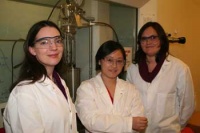The degradable polymer is made from sugars known as lignocellulosic biomass, which come from non-food crops such as fast-growing trees and grasses, or renewable biomass from agricultural or food waste.
It is being developed at Imperial College London by a team of Engineering and Physical Sciences Research Council scientists led by Dr Charlotte Williams.
The search for greener plastics, especially for single-use items such as food packaging, is the subject of significant research worldwide. ’It’s spurred on not only from an environmental perspective, but also for economic and supply reasons,’ explained Dr Williams.
Around seven per cent of worldwide oil and gas resources are consumed in plastics manufacture, with worldwide production exceeding 150 million tons per year. Almost 99 per cent of plastics are formed from fossil fuels.
’Our key breakthrough was in finding a way of using a non-food crop to form a polymer, as there are ethical issues around using food sources in this way,’ said Dr Williams. Current biorenewable plastics use crops such as corn or sugar beet.
’For the plastic to be useful it had to be manufactured in large volumes, which was technically challenging. It took three-and-a-half years for us to hit a yield of around 80 per cent in a low energy, low water use process,’ explained Dr Williams.
This is significant as the leading biorenewable plastic, polylactide, is formed in a high energy process requiring large volumes of water. In addition, when it reaches the end of its life, polylactide must be degraded in a high-temperature industrial facility.
In contrast, the oxygen-rich sugars in the new polymer allow it to absorb water and degrade to harmless products - meaning it can be tossed on the home compost heap and used to feed the garden.
Because the new polymer can be made from cheap materials or waste products it also stacks up economically compared to petrochemical-based plastics.
The polymer has a wide range of properties, laying the field open for a larger number of applications other than biorenewable plastic packaging. Its degradable properties make it ideal for specialised medical applications such as tissue regeneration, stitches and drug delivery. The polymer has been shown to be non-toxic to cells and decomposes in the body creating harmless by-products.
The team - including commercial partner BioCeramic Therapeutics, which was set up by Prof Molly Stevens and colleagues at Imperial - is also investigating ways of using the material as artificial scaffolds for tissue regeneration, as well as focusing on exploiting the degradable properties of the material to release drugs into the body in a controlled way.
Now the team is focused on developing the specific material characteristics needed for the packaging and medical areas.
’The development of the material is very promising and I’m optimistic that the technology could be in use within two to five years,’ said Dr Williams, who is already working with a number of commercial partners and is keen to engage others interested in the material.

The compostable polymer was developed by (left to right) Prof Molly Stevens, Dr Min Tang and Dr Charlotte Williams at Imperial College London





JLR teams with Allye Energy on portable battery storage
This illustrates the lengths required to operate electric vehicles in some circumstances. It is just as well few electric Range Rovers will go off...